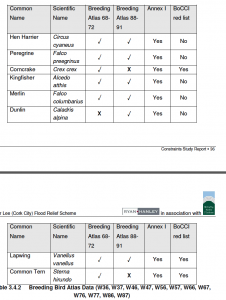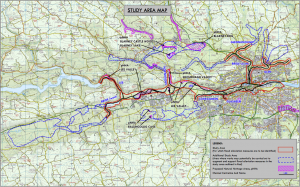Website that looks at the Lee catchment area and out the flood management strategy they have for the area. The Lee Fields FRS Constraints Study gives detailed on past and current studies done in the area. Here are the list of native and non native species that are familiar to the Lee Fields area but who’s habitat are in danger.
Smooth Newt (Lissotriton vulgaris) and Common Frog (Rana temporaria)
One scarce parasitic woodland plant Ivy Broomrape (Orobanche hederae) which grows parasitically on Ivy (Hedera helix) is known from the Distillery Fields area
Many of the stone walls in Cork City support a diverse array of species including two listed under the Flora (Protection) Order, 1999, i.e. Roundleaved Cranesbill and Little Robin. These are listed as nationally ‘Vulnerable’ in the Irish Red Data Book
Roundleaved Cranesbill is found in very few sites in Ireland, one of which is waste ground areas around the city, where it has been recorded in greater numbers than at any of its other sites in Dublin and Wexford (Cork City Council, 2009).
According to (Cork City Council, 2009) the River Lee running west from the City to the Lee Fields is an excellent area for bats. Bats species recorded present include Common Pipistrelle, Soprano Pipistrelle, Daubenton’s Bat, Leisler Bat and Brown-long eared Bat. Natteries and Whiskered Bat have also been recorded in the environs the City
The Annex I bird species Kingfisher (Alcedo atthis) is known to occur on the River Lee along the Irish Dipper (Cinclus hibernicus). The River Lee supports a number of bird species of Special Conservation Interest listed for the coastal marine habitats of Cork Harbour SPA e.g Cormorant (Phalacrocorax carbo) and Grey Heron (Ardea cinerea)
European Eel (Anguilla anguilla), Salmon (Salmo salar) and Brown trout (Salmo trutta) were recorded. Sea Lamprey have also been recorded downstream of Lee Waterworks Weir. It is not known if these species can move upstream above the weir.
A recent survey by IWT (2012) undertaken between 2011 and 2012 to evaluate the Otter population in the inner city and the adjacent suburban areas identified a minimum population of 11 No.
O Mahony (2009) also describes an area of swampy scrub wood at the western boundary of the Lee Fields on the northern banks as being of ecological interest and refers to a series of small ponds in the eastern extremity of the Lee Fields containing Tubular Water Dropwort (Oenanthe fistulosa).
The Study Area was visited on the 18th June 2013 – non native species
Japanese Knotweed (Fallopia japonica) and other members of the knotweed family
o Giant Hogweed (Heracleum mantegazzianum).
o Himalayan Balsam (Impatiens glandulifera)
o Travellers Joy (Clematis vitalba)
o Snowberry (Symphoricarpos alba)
o Himalayan Honeysuckle (Leycesteria formosa)
o Winter Heliotrope (Petasites fragrans)
o Ground Elder (Aegopodium podagraria)
o Montbretia (Crocosmia x crocosmiiflora)
The following aquatic non-native invasive species is known from the River Lee and Carrigadrohid reservoir:
o Nutall’s Pondweed (Elodea nuttallii)
List of Birds in Danger:

